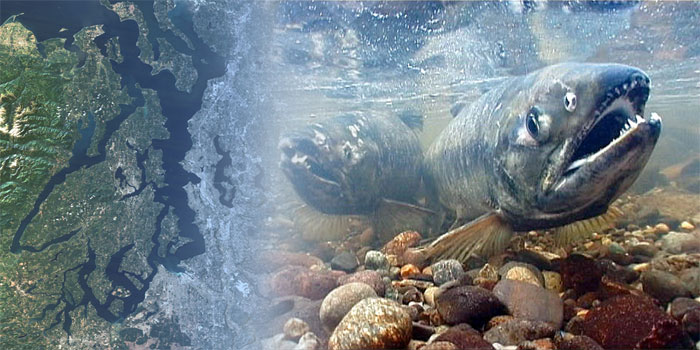Salmon Recovery Modeling

Puget Sound modeling for salmon recovery
n the spring of 2002, PRISM (Ray Hilborn, Mary Rucklehaus, Jeff Richey) sponsored a course exploring modeling tools to evaluate the consequences of habitat change on salmon, with a particular emphasis on salmon restoration activities. Speakers from academia, tribes and state, local and federal agencies presented empirical and modeling work focusing on linkages between salmon and their habitats. The course featured PRISM as a research and data-sharing platform, and provided a launching point for several collaborative research projects aimed at solving real conservation problems in Puget Sound:
The first Snohomish project involved a collaborative effort among UW (Hilborn), NOAA Fisheries Science Center, and the Snohomish watershed Technical Committee and Policy Forum initiated in the fall of 2002. The collaborative work involved taking alternative habitat restoration strategies developed by the Snohomish watershed group and translating those into habitat conditions and their effects on Chinook population dynamics. The model used to link changes in habitat conditions to changes in Chinook population status is SHIRAZ. The Snohomish policy Forum used the modeling results as part of the basis for choosing the restoration strategy that is now the core of their salmon recovery plan (submitted to NOAA Fisheries in July, 2005). Results from the Snohomish work have been widely communicated throughout Puget Sound through the Shared Strategy process. Published manuscripts from this work are available from NOAA Fisheries.
A second generation project in the Snohomish Basin is now underway through collaboration between NOAA Fisheries Science Center and Rick Palmer with the Climate Impacts Group at UW. This research, begun in the spring of 2004, is aimed at estimating:
- The effects of global climate change on local stream temperatures and flows
- The effects of land use changes on stream conditions
- The individual and interacting effects of climate and land use changes on salmon population status.
One of the purposes of this work is to ask how robust the recovery strategy chosen by the Snohomish watershed is to changes in future climate. The UW has provided downscaled climate impact predictions from 2 global climate models (i.e., GCM and Hadley) and has modeled changes in stream flows and temperatures from those climate impacts using the DHSVM model projections for the entire Snohomish Basin into the future to years 2025 and 2050. NOAA Fisheries provided estimates of alternative future land uses under current path and restoration scenarios; and also conducted the SHIRAZ modeling translating habitat impacts into salmon population status. Preliminary work suggests that salmon population status in the Snohomish will decline due to increases in peak flows during egg incubation and increases in stream temperatures and decreases in low flows during the spawning period. Habitat restoration efforts can mitigate against some of the negative impacts of climate in the short-term, but longer-term prospects for salmon are less clear. We have been discussing the results of this work with the Snohomish watershed technical group and the Snohomish policy Forum. We are continuing to work with the Snohomish group to discuss the implications of these results for implementation of their recovery strategy and adaptive management and monitoring programs. Possible next steps for this project are to collaborate with PRISM researchers to look at:
- Realistic future projections of land use changes and how their impacts interact with climate to affect freshwater habitat and salmon
- Puget Sound-wide estimates of changes in freshwater flows from the present to 2050 due to climate and land use changes.
A third project relating to developing and evaluating Puget Sound recovery strategies for salmon is an effort to build a metapopulation model that characterizes the status of all 22 remaining populations of Chinook in Puget Sound. This effort is a collaborative project between NOAA Fisheries Science Center and Jeff Richey. The PRISM environment is providing spatially and temporally explicit information on biological, physical and chemical attributes in marine sub-basins within Puget Sound. These Puget Sound environmental attributes are being used to develop models linking marine habitat conditions to salmon population status. The outcomes of this research will enable us to explore tradeoffs in habitat, hatchery, and harvest management aimed at increasing the likelihood that salmon recovery will occur. First results from this Sound-wide modeling are expected in the spring of 2006.


